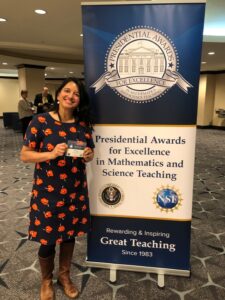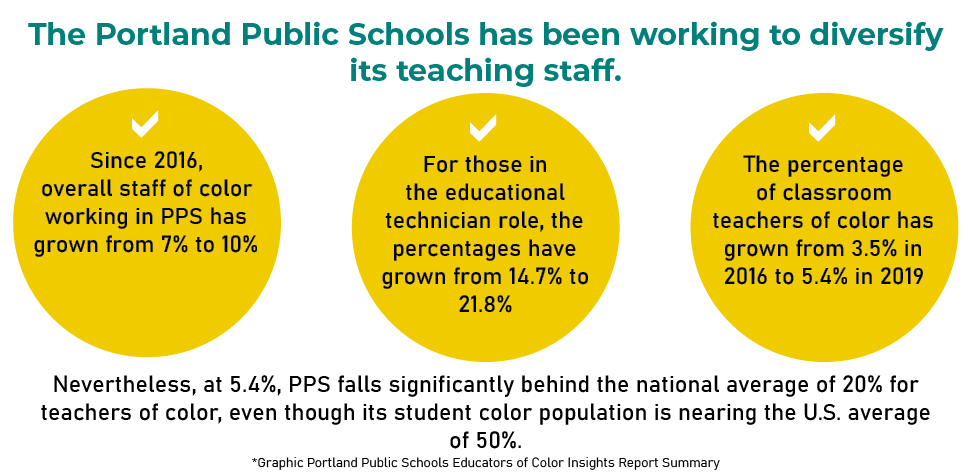Portland Public Schools Lead the Way in Change
49%.
That’s the number of students in Portland public schools that identify as people of color.
11%.
That’s the number of staff that do.
The large gap between the two is one Portland Public Schools is working hard to fill to create a workforce their students of color can better identify with, which studies show increases success for those students.

“The data shows that teachers of color in a community increase achievement for all students but in particular students of color,” said Priya Natarajan a math teacher, and one of the few BIPOC educators in the Portland school district.
Natarajan and Julia Hazel, who works on BIPOC issues in the district, are among several educators who host and organize monthly meetings with other educators of color. They’re also now part of a workgroup to generate ideas on how to better recruit teachers of color, understand the barriers, and work to learn what supports are needed to keep those educators in the district. The work is funded, in part, by a grant Portland Public Schools received from the Barr Foundation and The New Teacher Project (TNTP) through their Driving Toward Diversity in Educator Workforce program.
“This is a challenging time. We hope this will help move the needle toward more action, more change, and better results for both students and teachers,” said Leah Hamilton the Director of Education for the Barr Foundation.
“I think, big picture, we are thinking strategically and structurally. I have talked to BIPOC ed techs who want to beome teachers and now I need to think-how do we create a pathway where people know where to go where they figure out that next step and what are the supports to help them make that transition.”
Julia Hazel
The District’s goal is to build a pipeline of teachers of color who choose to stay employed in Portland. To move in that direction, the District surveyed its current staff and students, with some of the findings moving black educator, Julia Hazel, to action taking her from teacher to the Director of BIPOC career pathways and leadership development.
Hazel says the survey findings showed current students and staff feel isolated and dismissed with the assumption they were less skilled because of their accents. In response, Portland Public Schools created Hazel’s position which will help guide the diversity work. Hazel believes the new grant will help bring Portland closer to growing the BIPOC workforce by, in part, supporting current BIPOC school employees transition into teaching positions.
“I think, big picture, we are thinking strategically and structurally. I have talked to BIPOC ed techs who want to become teachers and now I need to think-how do we create a pathway where people know where to go where they figure out that next step and what are the supports to help them make that transition,” said Hazel.
What the Changes Can Mean for Students
While Maine has become more diverse over the years, the 2020 census still shows the Pine Tree State as the whitest in the nation. For parents of color, like Natarajan who teaches in Portland the importance of increasing diversity for her son, and other students in the district stems from her own experiences as a child growing up in West Virginia where not even one of her teachers was anything but white, until she went to college.

“We live in a multicultural world, and we want students to have the experience of learning from and getting along with and understanding all kinds of people. And that’s not just from their peers, but also from their teachers and learning from and with a variety of people is really critical.”
Priya Natarajan
“I was born in India, and I moved to West Virginia when I was 7, and that’s where I grew up; my whole schooling was in Appalachia. I had wonderful teachers, they were kind to me but there was always a sense, there is a part of my life experience they could not access. They were caring and nice but there was that part of me-that immigrant experience-the English learner experience, having brown skin, having a different religion, all of those pieces they never addressed, and therefore I felt I couldn’t really bring it into the classroom with me. I had to leave it at home, and as a result I never quite felt like I was being myself at school,” said Natarajan.
Improving school life for students is critical for Natarajan so children in Portland have adults who identify with their backgrounds, culture, and any possible barriers to learning.
Education research finds that students of color who learn from teachers of color are more likely to complete high school, go onto college, face fewer suspensions and disciplinary action, and be referred to gifted and talented programs, according to education research that points to the importance of having a diverse workforce that identifies with its students.
“We live in a multicultural world, and we want students to have the experience of learning from and getting along with and understanding all kinds of people. And that’s not just from their peers, but also from their teachers and learning from and with a variety of people is really critical,” said Natarajan.
Portland is putting its grant to use immediately and hopes to have more work groups and discussions on the hiring process now and through the summer. The work will highlight the district’s current strengths in the hiring process while also gaining an understanding of their weaknesses, and ultimately Barr Foundation and TNTP will offer support and recommendations for improving district diversity among the staff.




